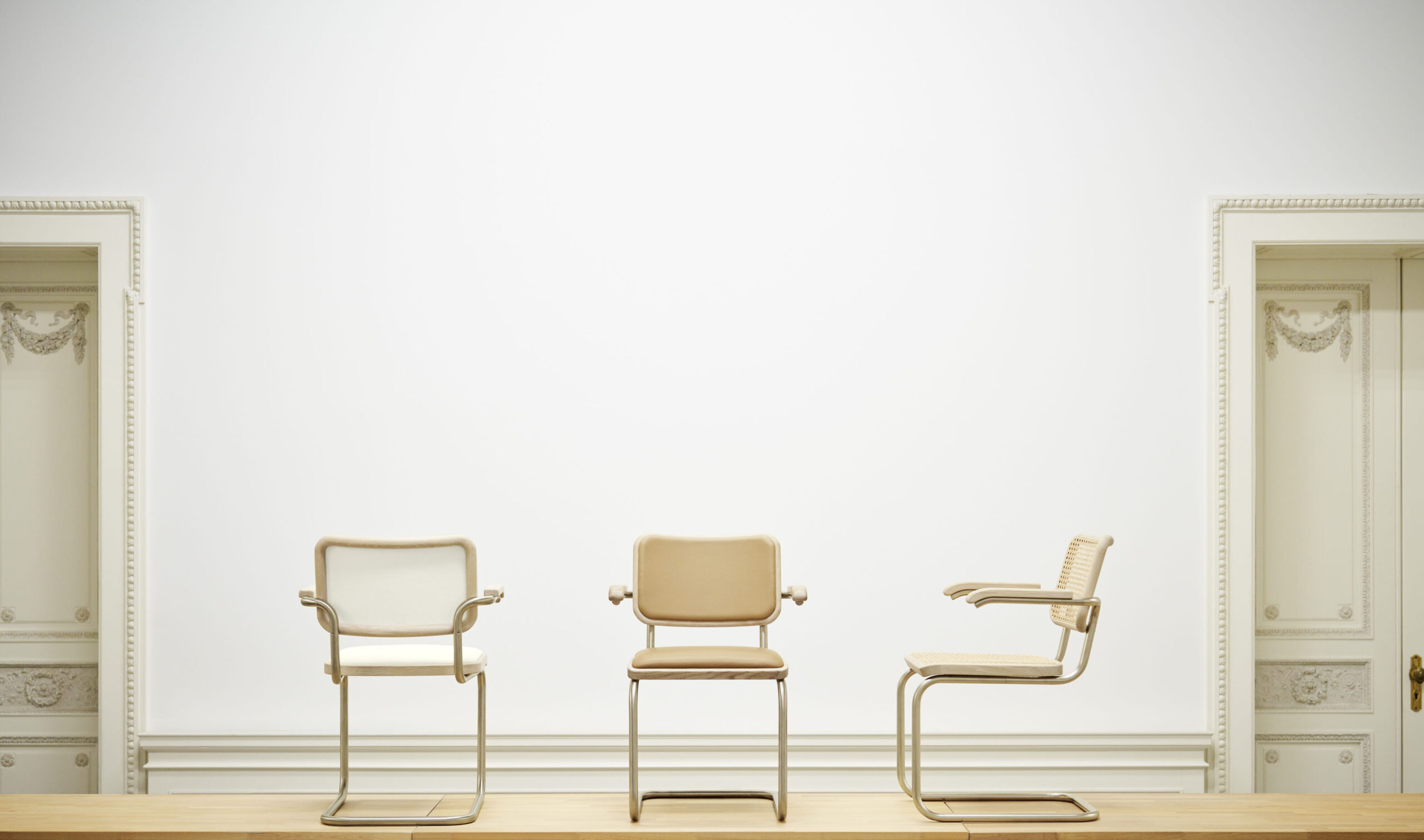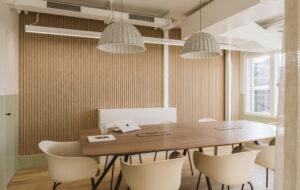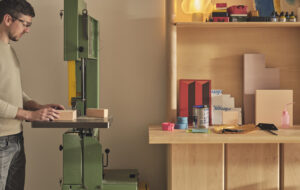 The impressive full-height atrium. Black water pools add a greater sense of depth|2 Kingdom Street’s external mullions set it apart from its two glass neighbours|A glass block on the floor allows natural light to penetrate the underground studio space|Coloured fins animate the reception area while the desk echoes the diagonal lines of the site|Acoustic panels help to absorb sound and the concrete columns feature halos|Clean floor plates are the workhorse of the building|The upper floors command cinematic views of Maida Vale and Little Venice||
The impressive full-height atrium. Black water pools add a greater sense of depth|2 Kingdom Street’s external mullions set it apart from its two glass neighbours|A glass block on the floor allows natural light to penetrate the underground studio space|Coloured fins animate the reception area while the desk echoes the diagonal lines of the site|Acoustic panels help to absorb sound and the concrete columns feature halos|Clean floor plates are the workhorse of the building|The upper floors command cinematic views of Maida Vale and Little Venice||
KPF has added its own individual piece to the Paddington Central jigsaw
2 Kingdom Street by KPF is the latest piece in Development Securities’ gigantic mixed-use puzzle, Paddington Central. Located in an area of town that’s generally known for Brunel’s train station, a stop–motion bear and a fairly gritty urban sprawl, the scheme aims to establish Paddington as a business hub.
2 Kingdom Street (named after the legendary engineer) is the second office erected on the site, after Sheppard Robson’s neighbouring 1 Kingdom Street, and houses a sizable 72,000sq m of office space.
It’s big. But it was supposed to be bigger. Enticing corporate bods away from the dynamism of the city was always destined to be an uphill struggle and the scheme was forced to undergo some radical resizing.
“It was originally going to be a very long building,” explains KPF principal John Bushell. “But no one wanted to come from the city on this building’s scale.”
To solve this problem the practice took the Gordian knot approach and chopped the scheme in half. Even so, the budget tipped the scales at a hefty £88 million.
“There was a certain amount of discipline, but it’s a good budget. They were very, very good clients who cared about the architecture,” says Bushell.
Following the same parti, parallel to the Westway, 2 Kingdom Street stands at one end of a diagonal axis that stretches across the site. A pair of large glass boxes on either side, the corners of which resemble giant goalposts, neatly frames the building. With so many glass constructions already in the district, KPF felt it was important to distinguish their addition.
“All glass buildings can appear quite dark,” says Bushell. “We were trying to get the variety of what you would have in a city rather than an office park.”
Therefore the practice created a kind of exoskeleton with the steel mullions fixed to the glass exterior. This creates a mixture of light and shade, making the facade appear to shimmer. It clearly speaks the same architectural language as its surroundings, albeit with a different accent, but one can’t help be reminded of a gargantuan toast rack.
“This is essentially a very diligent version of a basic animal”
Once inside, visitors are greeted by a diagonal reception desk set against a colourful backdrop of illuminated fins. The lobby is interspersed with three large concrete columns lit up by halos at their summits and on the far wall acoustic fin panels muffle the inevitable echo from the double height ceiling.
Venture deeper and the building opens up into a chasmal glass atrium that extends to the structure’s full height while acting as a buffer to the Westway. Black water pools give the illusion of greater depth to the space. In a multi-let building the question of who owns the public space is bound to raise its head. It is a conundrum KPF is fighting to solve.
“We always try to insure atriums are not sterile spaces, but unfortunately it is a battle when you have multiple tenants. We don’t want to leave a vast amount of space unclaimed so we are trying to get a café,” explains Bushell.
Understandably, take-up has been slow with only the top two floors being rented by biopharmaceutical company AstraZeneca so far. As a result the building currently feels a little like a ghost town. The sole occupier may be a white-collar animal, but KPF has more diverse aspirations for the building’s eventual inhabitants. Concealed beneath the atrium floor is a series of workshop spaces, their presence hinted at by a glass block carved into the atrium floor.
“There is an idea of attracting completely different types of people, like informal web-based media types that would not ordinarily look at a new office building. It seemed a pity to define it too much so we’ve left it pretty raw,” says Bushell.
The ten upper levels, or the “workhorse” as Bushell likes to call them, are the Kingdom Street’s raison d’etre.
Simplicity is the watchword. Large clean floor plates are raised up high above the mess of Paddington, providing rather splendid views over Maida Vale. Sadly, Allies and Morrison’s building will soon obstruct this vista.
The final piece of the patchwork, it will sit directly in front of the current occupant. Due to the location and expanse of the floors, natural ventilation was not only impractical, but also unwise (unless of course carbon monoxide poisoning is the order of the day). On the Westway side the floor tapers down into an arrowhead, nicknamed “the prow”, which continues the diagonal line that begins as you enter Paddington Central.
“We always try to insure atriums are not sterile spaces, but unfortunately it is a battle when you have multiple tenants”
On the top floor the facade cuts back to form a balcony, while adjacent to the prow is the building’s fire stair, which dangles down over the Westway. Again, it is predominantly glazed to prevent it from being “embedded in darkness”, thereby encouraging the occupants to adopt it as the primary means of traversing the floors.
To KPF’s annoyance, 2 Kingdom Street’s original plan for the rooftop was compromised by objections from local residents. After a lot of toing and froing it was agreed to slope the roof back away from the nearby housing.
“The apparent regularity is compromised at the top and I don’t think the building needs it,” says Bushell.
However, the relationship between client and architect couldn’t have been better, summed up as “exemplary” by Bushell. KPF are to be applauded for their commitment to sustainability, achieving a BREEAM Excellent rating, no mean feat on a project this size.
“This is essentially a very diligent version of a basic animal,” explains Bushell.
Further kudos is due for the practice’s involvement with the Soft Landings scheme, which ensured the incumbent facilities manager wasn’t left with a 500-page user manual and a pat on the back when the keys were handed over.
According to Bushell, this was the first time KPF had embarked on this scheme. “Many months before we handed it over we went through a checklist of things. We basically held their hand a lot more.”
This can only be good news. All the BREEAM ratings in the world mean diddlysquat if the building’s potential is not being realised. Bushell sees this project as a step on the way to a truly sustainable building.
“We are very proud of the mixture of very simple office space and very interesting surroundings,” he concludes.
























